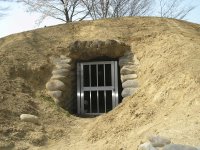 Before spending time in Ashikaga, I had not been aware how widespread in Japan were the mound tombs known as 古墳 kofun lit. 'ancient grave'. When we walked over to Ashikaga Park to see the cherry blossoms there two weeks ago, we found that the hillside park includes 12 kofun, two of which have small, blocked-off, stone passageways facing east. (You would enter facing west.) I had always associated kofun with western Japan, where the largest imperial tombs were built, but an article on the Kofun Period (A.D. 300–700) by Sophia University archaeology professor Charles T. Keally set me straight.
Before spending time in Ashikaga, I had not been aware how widespread in Japan were the mound tombs known as 古墳 kofun lit. 'ancient grave'. When we walked over to Ashikaga Park to see the cherry blossoms there two weeks ago, we found that the hillside park includes 12 kofun, two of which have small, blocked-off, stone passageways facing east. (You would enter facing west.) I had always associated kofun with western Japan, where the largest imperial tombs were built, but an article on the Kofun Period (A.D. 300–700) by Sophia University archaeology professor Charles T. Keally set me straight.Ashikaga has always struck me as a city of Old Money, but I never thought it went back quite that far.Origins:
- The first excavation of a mound tomb in Japan was conducted my Mito (Tokugawa) Mitsukuni in 1692, the 5th year of the Genroku era. Mitsukuni (1628-1701) was the grandson of Tokugawa Ieyasu, founder of the Tokugawa Shogunate. The tomb he excavated is called the Samuraizuka Kofun, located in Ohtawara City, Tochigi Prefecture, just north of Tokyo. This excavation is considered the first academic, or scientific, excavation conducted in Japan.
The origins of the Kofun Period mound tombs is clearly in the Yayoi Period, although ultimately continental influence might well be a factor, too. The most common Yayoi burials were in the ground in a square area delimited by a ditch or moat. The burial in the middle had a low mound over it. Toward the end of Yayoi, some of these ditches or moats became round. With higher mounds, these were the most common kofun tomb in the Kofun Period, but the burial was on top of the mound instead of under it. The square mounds, too, continued from Yayoi into Kofun, but these later ones also had the burial in the top of the mound instead of under it.
Forms:
The most distinctive mounds of the Kofun Period are the keyhole-shaped mounds, thought to be associated with the Imperial Family. This shape is uniquely Japanese and its origins are unknown. But Korean archaeologists recently have identified a few contemporary mound tombs in southeastern Korea that they say are also keyhole-shaped. Some people try to use these recent Korean finds to argue for a Korean origin of the keyhole-shaped mound tombs. But this fails to explain why this shape is rare in Korea and only recently recognized there through excavation, whereas this shape is common in Japan, obvious without excavation, and has been known for centuries....Regions:
Mound tombs, especially the larger ones, tend to be located in clearly defined regions. Mound tombs are common in Kyushu only in the northwest, especially in the Chikugo River plain in Saga and southern Fukuoka prefectures. There is another such concentration of tombs in the eastern part of the Inland Sea in Okayama Prefecture on Honshu island and just across the water in Kagawa and Tokushima prefectures on Shikoku island. Similar concentrations are found in eastern Shimane Prefecture from Izumo to Matsue City on the Sea of Japan, in Nara and Kyoto prefectures, along the shores of Ise Bay from Nagoya to Ise, in Ishikawa Prefecture on the Sea of Japan, on the Kanto Plain in eastern Japan (especially in North Kanto), and on the Sendai Plain in northern Japan. There are smaller concentrations of tombs in Shizuoka Prefecture, and in the intermontane basins around Nagano, Yamagata and Kofu cities.Archaeologists identify these concentrations with regional power centers, and they identify small clusters of tombs within these concentrations with the various clans known from later documents. In the north, keyhole-shaped mounds appeared in the Sendai Plain as early as the 5th century; the northern-most such tomb is in southern Iwate Prefecture. But most tombs in the northern regions are later. This northern region was the frontier with the Emishi barbarians who lived in northern Tohoku. Keyhole-shaped mound tombs are extremely rare in southern Kyushu, the home of the Hayato barbarians.
No comments:
Post a Comment